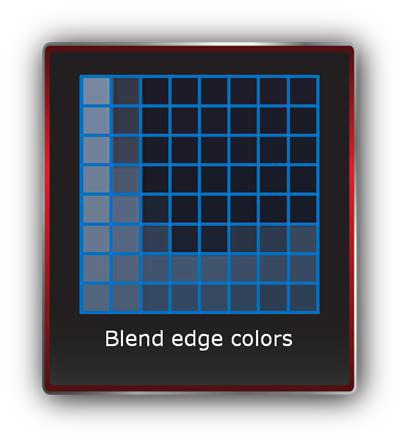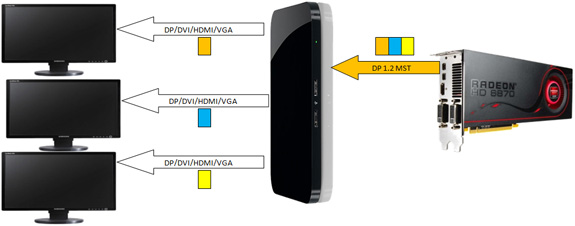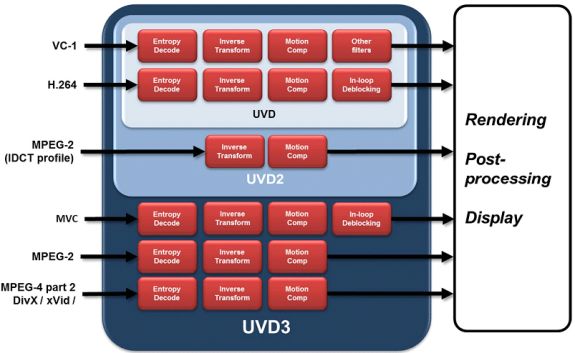AMD's Radeon HD 6970 & Radeon HD 6950: Paving The Future For AMD
by Ryan Smith on December 15, 2010 12:01 AM ESTRefresher: The 6800 Series’ New Features
Back in October AMD launched the first 6000 series cards, the Barts-based Radeon HD 6800 series. At their core they are a refreshed version of the Cypress GPU that we saw on the 5800 series, but AMD used the opportunity to make some enhancements over the standard Cypress. All of these enhancements apply throughout the 6000 series, so this includes the 6900 series. As such for those of you who didn’t pay much attention to the 6800 series, we’re going to quickly recap what’s new in order to lay the groundwork for further comparisons of the 6900 series to the 5800 series.
We’ll start with the core architecture. Compared to Cypress, Barts is nearly identical save 1 difference: the tessellator. For Barts AMD implemented what they call their 7th generation tessellator, which focused on delivering improved tessellation performance at lower tessellation factors that AMD felt were more important. Cayman takes this one step further and implements AMD’s 8th generation tessellator, which as the naming conventions implies is the 7th generation tessellator with even further enhancements (particularly those necessary for load balancing).
The second change we saw with Barts and the 6800 series was AMD’s refined texture filtering engine. AMD’s texture filtering engine from the 5800 set new standards by offering angle independent filtering, but it had an annoying quirk with highly regular/noisy textures where it didn’t do a good enough job blending together various mipmaps, resulting in visible transitions between them. For the 6800 series AMD fixed this, and it can now properly blend together noisy textures. At the same time in a controversial move AMD tweaked its default filtering optimizations for the 5800 series and entire 6000 series, leading to these cards producing imagines subtly different (and depending on who you ask, subtly worse) than they were on the 5800 series prior to the Catalyst 10.10 drivers.

| Radeon HD 5870 | Radeon HD 6870 | GeForce GTX 480 |
The third change we saw was the introduction of a new anti-aliasing mode, initially launched on the 6800 series and backported to the 5800 series shortly thereafter. Morphological Anti-Aliasing (MLAA) is a post-processing filter that works on any (and all) images, looking for high contrast edges (jaggies) and blending them to reduce the contrast. Implemented as a compute shader, it works with all games. As it’s a post-processing filter the results can vary – the filter has no knowledge of depth, polygons, or other attributes of the rendered world beyond the final image – so it’s prone to blending everything that looks like aliasing. On the plus side it’s cheap to use as it was originally designed for consoles with their limited resources, so by not consuming large amounts of memory & memory bandwidth like SSAA/MSAA it usually has a low performance hit.


Last but not least, AMD made a number of changes to their display hardware. The Universal Video Decoder (UVD) was upgraded to version 3, bringing full decode support for MPEG-2, MPEG-4 ASP, and H.264 MVC (packed frame video for 3D movies). For the 6900 series this is not of great importance as MPEG-2 and MPEG-4 ASP are low complexity codecs, but it does play an important role for AMD’s future APU products and low-end GPUs, where offloading these low complexity codecs is still going to be a big relief for the slower CPUs they’re paired with. And on that note the first public version of the DivX codec with support for UVD3 will be shipping today, letting 6800/6900 series owners finally take advantage of this functionality.
The second of the major display changes was the addition of support for the DisplayPort 1.2 standard. DP1.2 doubles DisplayPort’s bandwidth to 21.6Gbps, finally giving DisplayPort a significant bandwidth lead over dual-link DVI. With double the bandwidth it’s now possible to drive multiple monitors off of a single root DisplayPort, a technology called Multi Stream Transport (MST). AMD is heavily banking on this technology, as the additional bandwidth coupled with the fact that DisplayPort doesn’t require a clock source for each monitor/stream means AMD can drive up to 6 monitors off of a single card using only a pair of mini-DP ports. AMD is so cutting edge here that like the 6800 series the 6900 series is technically only DP1.2 ready – there won’t be any other devices available for compliance testing until 2011.

Finally, the 6800 series also introduced support for HDMI 1.4a and support for color correction in linear space. HDMI 1.4a support is fairly straightforward: the 6000 series can drive 3D televisions in either the 1080p24 or 720p60 3D modes. Meanwhile support for color correction in linear space allows AMD to offer accurate color correction for wide gamut monitors; previously there was a loss of accuracy as color correction had to be applied in the gamma color space, which is only meant for use for display purposes. This is particularly important for integrating wide gamut monitors in to traditional gamut workflows, as sRGB is misinterpreted on a wide gamut monitor without color correction.
While all of these features were introduced on the 6800 series, they’re fundamental parts of the entire 6000 series, meaning they’re part of the 6900 series too. This provides us with a baseline set of improvements over AMD’s 5800 series, on top of the additional improvements Cayman and AMD’s VLIW4 architecture brings.











168 Comments
View All Comments
fausto412 - Wednesday, December 15, 2010 - link
6970 just 4 to 6 fps faster in Bad Company 2 than my 5870? WTF!not worth the upgrade. what a lame ass successor.
Kibbles - Wednesday, December 15, 2010 - link
It's 7% faster at 1920 and 9% faster at 2560. BC2 obviously doesn't need the extra GPU power at 1680.I wouldn't call it weak, but this card certainly isn't the clear winner that the 5870 was.
fausto412 - Wednesday, December 15, 2010 - link
its weak if i was expecting a response to the gtx580 to upgrade to.may as well stay with my 5870.
ClownPuncher - Wednesday, December 15, 2010 - link
For now... But who really bases their purchase on one game anymore? It looks like 10.12 or 11.1 drivers will help performance a good amount.fausto412 - Wednesday, December 15, 2010 - link
I base my performance on 1 game...because it is a very taxing game and my #1 game right now.MeanBruce - Wednesday, December 15, 2010 - link
Yup, dude I heard the AMD 7000 series might make an early appearance next July, with the die shrink @28nm you might want to wait and pick up a 7970!fausto412 - Wednesday, December 15, 2010 - link
that's what i'm considering now. need to upgrade for 30% more performance than 5870 for it to make sense.Stuka87 - Wednesday, December 15, 2010 - link
The game is CPU limited at lower resolutions. BC2 is known for being more CPU bound than GPU bound.But I was hoping for a larger jump over the previous cards :/
fausto412 - Wednesday, December 15, 2010 - link
I understand BFBC2 is more cpu bound. But in this testing Anandtech did they use a TOP TOP TOP of the line cpu so that rules that out as a bottleneck.Belard - Wednesday, December 15, 2010 - link
Yeah... at least the model numbers didn't make things confusing!In some benchmarks, the 6950 is faster than your 5870... but it would have made far more sense to call these 6850/6870 or even 6830/6850..
AMD screwed up with the new names...